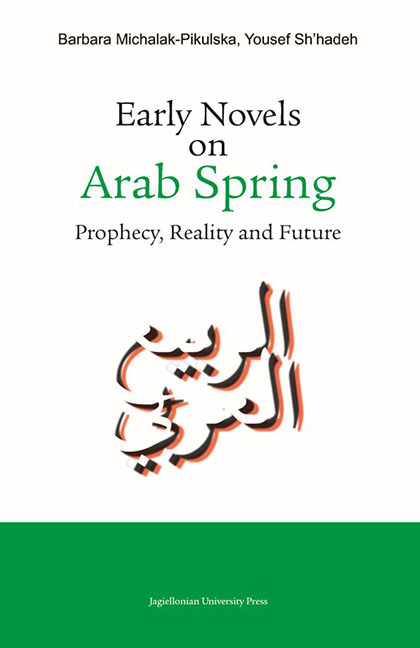Book contents
- Frontmatter
- Contents
- Introduction
- Part I Awakening of the Awareness of Subjugation – The Prophecy of the Spring of Nations in Arab Novels
- Part II At the Heart of the Arab Spring Events
- Part III The Future: The Spring Continues
- 17 Mu‘Taṣim Aš - Šā‘Ir : Uhzūǧat ar-raḥīl (A Song of Departure) and Fī intiẓār as-sulaḥfāt (Waiting for a Turtle)
- 18 Aḥmad ‘Abd Al - Malik : Al-Aqni‘a (Masks)
- 19 Ṭayba Aš - Šarīf Al - Idrīsī : Ḥaǧar min saqar (A Stone from Hell)
- 20 Amīra Aš - Širbīnī : ‘Itq (Liberation)
- 21 ‘ Izz Ad - Dīn Šukrī Fašīr : Bāb al-ẖurūǧ – risālat ‘Alī al-muf‘ama bi-bahǧa ġayr mutawaqqa‘a (The Gate to Leave – Ali’s Letter Filled with Unexpected Joy)
- Conclusion
- Bibliography
- Summary in Arabic
9 - Nāṣir ‘ Irāq : Tāǧ al-hudhud (Hoopoe Crown)
Published online by Cambridge University Press: 13 October 2023
- Frontmatter
- Contents
- Introduction
- Part I Awakening of the Awareness of Subjugation – The Prophecy of the Spring of Nations in Arab Novels
- Part II At the Heart of the Arab Spring Events
- Part III The Future: The Spring Continues
- 17 Mu‘Taṣim Aš - Šā‘Ir : Uhzūǧat ar-raḥīl (A Song of Departure) and Fī intiẓār as-sulaḥfāt (Waiting for a Turtle)
- 18 Aḥmad ‘Abd Al - Malik : Al-Aqni‘a (Masks)
- 19 Ṭayba Aš - Šarīf Al - Idrīsī : Ḥaǧar min saqar (A Stone from Hell)
- 20 Amīra Aš - Širbīnī : ‘Itq (Liberation)
- 21 ‘ Izz Ad - Dīn Šukrī Fašīr : Bāb al-ẖurūǧ – risālat ‘Alī al-muf‘ama bi-bahǧa ġayr mutawaqqa‘a (The Gate to Leave – Ali’s Letter Filled with Unexpected Joy)
- Conclusion
- Bibliography
- Summary in Arabic
Summary
Contemporary prose has become involved in the affairs of the country, as it attempts to chronicle how citizens finally became aware of their subjugation and entrapment by lies. In these changed circumstances a new vision of reality develops and forms dynamically. The novel Tāǧ al-hudhud (Hoopoe Crown) is the story of a young journalist Mu‘tazz who is passionate about birds and various animals. The man falls in love with an extremely rebellious girl called Našwā. However, she is in love with Mu‘tazz’s friend Adham aš-Šāḏilī, with whom she bonds in a revolutionary passion and through a shared approach to the world and its problems. Mu‘tazz is heartbroken and withdraws from active life, instead focusing his attention on observing animals. When he looks at them, he is reminded of his grandmother’s stories.
The author presents the political and social realities in Cairo before the revolution on January 25, by showing young people’s dreams and their hopes for a better life. Tahrir Square is shown, where millions of people protest against Mubarak and his regime. Interestingly, Mu‘tazz appears among the crowd, crying after a wounded bird (a hoopoe) and expressing his regret and longing for his beloved Našwā.
Subsequent events intertwine smoothly, which makes the novel easy and pleasant to read. The symbolism of the injured bird represents Egypt wounded by the Mubarak dictatorship. The bird “in the Qur’an is often synonymous with destiny, because of the future and fate of divination from the flight of birds.” In addition, according to Muslim tradition; “the souls of the faithful change into birds sitting on the tree of life after death, and the souls of the infidels will be turned into birds of prey.” Finally, the hoopoe (Arabic: hudhud) in the Muslim tradition “is a bird of the king and prophet Solomon (Sulaymān), a symbol of wisdom and a messenger with good news.” And Christian iconography from the fourth to the twentieth century, “in order to reflect the spiritual nature of angels, depicted them as winged, beautiful, youthful human figures of the unspecified sex, dressed in trailing robes.
- Type
- Chapter
- Information
- Early Novels on Arab SpringProphecy, Reality and Future, pp. 55 - 62Publisher: Jagiellonian University PressPrint publication year: 2022

